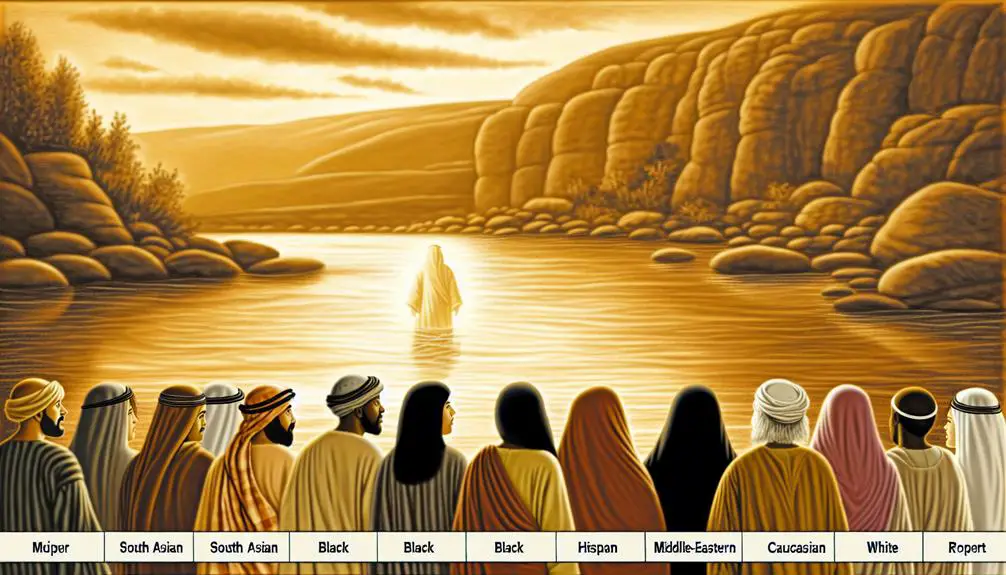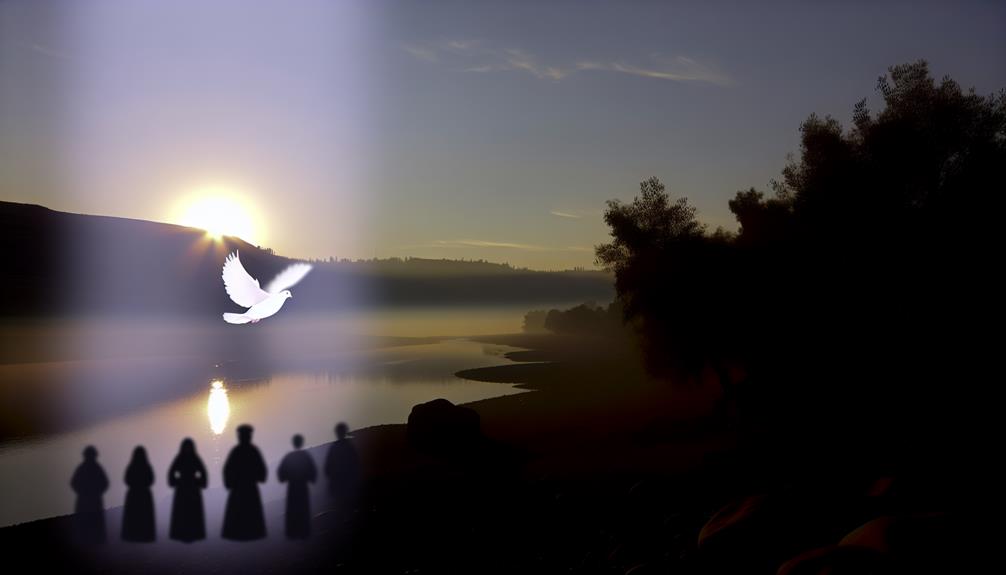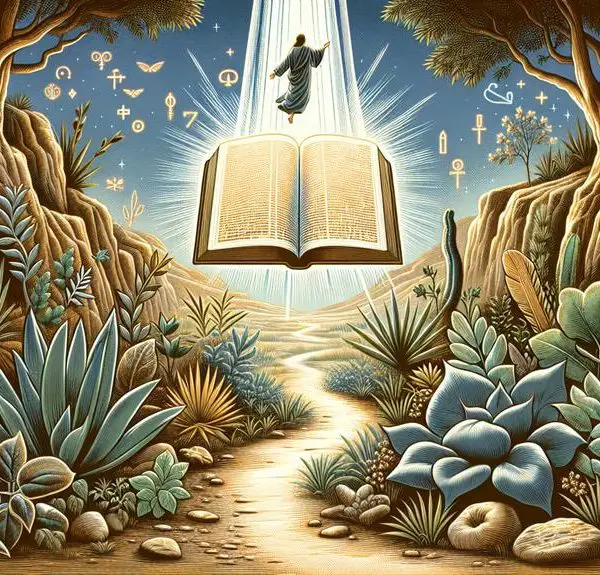Find out how the Jordan River's biblical significance extends beyond its waters, symbolizing spiritual journeys and divine promises.

Meaning of Jordan in the Bible
Did you know that the Jordan River is mentioned over 180 times in the Bible?
This fact alone underscores its significance in biblical narratives, serving not just as a geographic landmark but as a symbol rich with spiritual meaning.
You might be familiar with its role in stories of baptism and miraculous crossings, but there's so much more to its significance.
From being a site of purification to a boundary crossed into the Promised Land, the Jordan holds layers of meaning that mirror the spiritual journey.
Let's explore these dimensions together, and you might find insights that resonate with your own path.
Key Takeaways
- The Jordan River symbolizes transition, marking the passage into new life phases and spiritual rebirth in biblical narratives.
- It represents purification and renewal, serving as a sacred site for baptism and acts symbolizing cleansing from the past.
- The river is a metaphor for life's journey, embodying barriers that require faith and divine intervention to overcome.
- Jordan signifies the believer's quest for salvation, embodying themes of redemption, spiritual enlightenment, and eternal promise.
Geographic and Historical Context

In analyzing the biblical significance of Jordan, it's essential to explore its geographical and historical context, which serves as a backdrop for many pivotal events described in the scriptures. The Jordan River, originating from the Anti-Lebanon and Mount Hermon ranges, has been more than just a river source; it's played a crucial role in the development and sustenance of the civilizations that have flourished on its banks.
Its significance is amplified when you consider its role in the ancient trade routes. These routes weren't merely passages for commerce but lifelines that facilitated the exchange of goods, ideas, and cultural practices across the region. They connected the people of Israel with distant lands, enabling them to engage with a wide array of cultures and economies.
The river's strategic location made it a central figure in the narratives of the Bible, providing not just physical sustenance but also a route for trade and interaction. As you delve deeper, you'll find that the Jordan's role in trade and its position as a river source have significantly influenced the events and stories that are foundational to biblical teachings, shaping the spiritual and physical landscape of the region.
Symbol of Transition and Entry
Crossing the Jordan River symbolizes a profound transition and entry into new phases of life, serving as a metaphorical gateway in biblical narratives. This river metaphor holds immense cultural significance, illustrating key moments of change and renewal.
The Jordan River's role as a boundary and passageway offers a rich tapestry for interpretation:
- Separation and Preparation: It represents the physical and spiritual separation from the past, preparing individuals for the challenges and blessings ahead.
- Cleansing and Renewal: Crossing it signifies a cleansing process, a preparation for a new beginning, akin to baptismal rites.
- Promise and Fulfillment: It embodies the transition from wandering to reaching the Promised Land, signaling divine fulfillment.
- Death and Resurrection: The crossing echoes themes of death to one's former self and rebirth into a new life of commitment and hope.
Understanding the Jordan River as more than just a physical location but as a symbol enriches one's grasp of its narratives and teachings. Its representation of transitions and thresholds offers a deeper insight into the personal and communal journeys of faith, illustrating how physical landscapes can mirror spiritual realities.
Site of Miraculous Events

Building on the rich tapestry of meanings associated with the Jordan River, it's pivotal to explore its role as the backdrop for numerous miraculous events recorded in the Bible. The river's significance transcends its physical attributes, serving as a stage for divine interventions that have shaped the course of biblical history. The Jordan's flora and unique geographical features haven't only provided sustenance and shelter but have also played a crucial role in these narratives, underscoring the interplay between the natural world and the divine.
The military significance of the Jordan can't be understated. It served as a natural barrier and a site of strategic advantage, where miraculous events often turned the tide of battles and conquests. These divine interventions along the Jordan underscored a belief in the power of faith and the presence of a guiding hand in the affairs of nations. Analyzing these events provides a deeper understanding of the Jordan's role in biblical narratives, revealing a complex interconnection between geography, faith, and the unfolding of divine will. Through this lens, the Jordan emerges not just as a river but as a symbol of divine intervention and guidance.
A Place of Baptism and Purification
Amidst its myriad roles, the Jordan River stands out as a sacred site for baptism and purification, pivotal to the spiritual journeys of biblical figures. Its waters, flowing from the Sea of Galilee to the Dead Sea, have witnessed countless acts of faith, symbolizing both physical and spiritual cleansing. The practice of baptism in the Jordan is deeply intertwined with the river's natural and cultural significance, shaping its historical identity.
The significance of the Jordan River extends beyond its spiritual connotations, touching upon the delicate balance between human activity and the natural world. Consider the following:
- Jordan wildlife: The river's ecosystem supports a diverse range of species, from fish to migratory birds, which thrive in its waters and adjacent habitats.
- Irrigation practices: These have evolved over centuries, impacting the river's flow and, consequently, the rituals performed in its waters.
- Impact on baptism sites: Changes in water levels and quality directly affect the accessibility and condition of sacred sites.
- Conservation efforts: These aim to preserve both the river's ecological integrity and its historical and spiritual significance.
Analyzing the Jordan River's role as a place of baptism and purification reveals a complex interplay between faith, culture, and the environment.
Prophetic Significance and Visions

Beyond its historical and ecological significance, the Jordan River also embodies profound prophetic meanings and visions that have shaped religious narratives and beliefs. The river's course through the biblical landscape isn't just a marker of physical boundaries but also a symbol of spiritual transitions and revelations. These visionary parallels are deeply embedded in the fabric of sacred texts, offering celestial interpretations that resonate with the faithful across generations.
The Jordan's flowing waters are often depicted as a divine conduit for prophecy, a boundary between the earthly and the divine. This duality presents a rich tapestry for analysis, where the river itself becomes a metaphor for spiritual journeying and enlightenment. Scholars have long debated the symbolic representations of the Jordan in prophetic visions, seeing it as a line of demarcation between the profane and the sacred, the known and the unknown.
In these narratives, the Jordan isn't merely a river but a threshold, inviting believers to contemplate deeper spiritual truths. Its presence in prophetic visions underscores the river's enduring role as a bridge between worlds, offering insights into the celestial realm. Through these interpretations, the Jordan transcends its geographical reality, becoming a pivotal element in understanding the complexities of faith and the divine.
Crossing Into Eternal Life
You'll find that the Jordan River's crossing symbolizes a profound transition in biblical narratives, marking a passage from earthly existence to the fulfillment of divine promise.
This act isn't merely a physical journey but encapsulates a spiritual ascent into eternal life, as envisioned by believers.
Analyzing this transition offers insights into the broader theological themes of redemption and salvation that permeate the scriptures.
Symbolic River Crossing
In biblical symbolism, crossing the Jordan River is often interpreted as a metaphor for transitioning into eternal life, reflecting a profound spiritual journey from the earthly to the divine. This crossing isn't merely a physical act but embodies a spiritual awakening and purification. The river's role in biblical narratives often presents:
- A barrier that requires divine intervention to overcome.
- A test of faith for those seeking to cross.
- An emblem of the transitions in life's journey.
- A boundary between the mortal realm and the promise of eternal peace.
The narratives surrounding the Jordan, involving military strategy and navigational challenges, further enrich its symbolic significance. They highlight the river's role as a spiritual threshold, underscoring the transformative journey of faith from the temporal world to eternal serenity.
Transition to Promise
Crossing the Jordan River symbolizes the believer's transition from a life of earthly trials to the promise of eternal peace in the biblical narrative. This pivotal moment isn't merely a physical crossing; it embodies a profound spiritual journey marked by covenant renewal and a significant leadership change.
As you delve deeper into this transition, you'll see it as a metaphor for the believer's passage into a renewed relationship with the divine, underscored by the shift from Moses' to Joshua's leadership. This change reflects not just a transfer of earthly authority but also highlights a deeper, spiritual realignment with God's promises.
The crossing into the Promised Land, therefore, isn't just a step into a geographical location but a leap into a promise of eternal communion and renewal.
Spiritual Rebirth and Salvation

One often finds that the Jordan River symbolizes a transformative passage into spiritual rebirth and salvation within biblical narratives. This sacred symbol represents not only physical crossing but also a profound metaphorical cleansing, marking the start of new beginnings. The river's purifying waters serve as a powerful emblem of washing away the old and embracing a new phase of spiritual enlightenment and redemption.
To understand the depth of this symbolism, consider the following points:
- Metaphorical Cleansing: The act of crossing or being baptized in the Jordan signifies the shedding of past sins and the purification of the soul.
- New Beginnings: It marks a critical turning point, where individuals embark on a renewed path of faith, hope, and devotion.
- Divine Intervention: The river is often depicted as a place where divine presence is palpable, offering guidance and blessing to those who seek spiritual salvation.
- Universal Metaphor: This symbolism transcends Christian narratives, resonating with universal themes of redemption, transformation, and the quest for a deeper spiritual connection.
Through the lens of the Jordan River, one gains insight into the multifaceted process of spiritual rebirth and the eternal promise of salvation, underscoring the river's enduring significance in the collective spiritual consciousness.
Frequently Asked Questions
How Has the Name "Jordan" Evolved in Its Linguistic Roots and Translations Across Different Cultures and Languages Since Biblical Times?
You've noticed that the name 'Jordan' has undergone significant transformations in its linguistic journey. By delving into Jordanian etymology, you'll uncover a rich tapestry of adaptations across cultures.
Through cross-cultural comparisons, it's clear that this name's evolution reflects diverse linguistic influences, reshaping its pronunciation and spelling.
This exploration isn't just about tracing a name; it's about understanding the intricate ways cultures interact and influence each other linguistically.
Are There Any Lesser-Known Myths or Folklore From Surrounding Regions That Feature the Jordan River in a Significant Way?
You're diving into the depths of regional folklore, uncovering tales where the Jordan River isn't just water flowing through landscapes but a realm of river deities and magical properties.
These stories, often overshadowed by more dominant narratives, offer a rich tapestry of cultural beliefs and practices. They reveal how communities perceived natural phenomena, attributing divine or mystical qualities to the river, influencing rituals and daily life in profound, yet frequently overlooked, ways.
How Has the Depiction of the Jordan River in Art and Literature Evolved From Ancient to Modern Times?
You've noticed how the Jordan River, much like a chameleon, has shifted its colors across the canvas of time. Initially captured in ancient texts and carvings, its essence was simplistic yet profound.
Fast forward, and you'll find it coursing through the veins of various artistic mediums, each offering their own modern interpretations.
This evolution reflects not just changing artistic styles but a deeper, scholarly insight into how we perceive and depict our natural world.
What Are the Environmental Challenges Facing the Jordan River Today, and How Have They Impacted Its Religious and Cultural Significance?
Today, you're facing environmental challenges like water scarcity and rising pollution levels in the Jordan River. These issues have drastically impacted its religious and cultural significance.
As water becomes scarcer, the river's ability to nurture the surrounding lands diminishes, affecting communities that have historically depended on it. The increase in pollution not only threatens the ecosystem but also tarnishes the river's sanctity, altering its role and meaning in cultural and religious practices.
How Do Contemporary Religious Leaders and Scholars Interpret the Symbolism of the Jordan River in the Context of Modern-Day Faith Practices and Ecological Concerns?
Diving into today's question, you'll find that contemporary religious leaders and scholars view the Jordan River as more than a mere trickle in faith's vast ocean.
They blend its historic significance with modern ecological concerns, highlighting rituals like river baptisms as acts of spiritual renewal.
This approach marries tradition with awareness, suggesting that preserving the river's health is akin to safeguarding a conduit for spiritual rejuvenation and communal identity.
Conclusion
In your exploration of Jordan in the Bible, you've uncovered its multifaceted significance, from a physical landmark to a symbol of spiritual metamorphosis.
Interestingly, the Jordan River is mentioned over 180 times in the Bible, underscoring its central role in biblical narratives and its enduring spiritual resonance.
This statistic not only highlights the river's physical presence but also enriches our understanding of its symbolic importance in marking transitions, miracles, and the profound journey towards spiritual rebirth and salvation.



Sign up